#men's medieval fashion
Text

So I got this tag on my answer to an ask about when it became acceptable for western women to wear pants, and you know it's all I need to go on a tangent.
I think the short answer here would be men have worn skirts as long as people have worn anything, so pretty long tbh. But since I am incapable of answering anything shortly, I think we can re-frame this question:
When did skirts stop being socially acceptable for men?
So let's start with acknowledging that tunics, togas, kirtles and such men wore through history were, in fact, skirts. I think there's often a tendency to think of these as very different garments from those that women wore, but really they are not. Most of the time they were literally referred to with the same name. (I will do a very broad and simplified overview of men's clothing from ancient times to Early Middle Ages so we can get to the point which is Late Middle Ages.)
Ancient Greek men and women both wore chitons. Even it's length wasn't determined by gender, but by occupation. Athletes, soldiers and slaves wore knee-length chitons for easier movement. Roman men and women wore very similar garment, tunics. Especially in earlier ancient Rome long sleeves were associated with women, but later became more popular and unconventional for men too. Length though was still dependent on occupation and class, not gender. Toga was sure men's clothing, but worn over tunic. It was wrapped around the waist, like a dress would, and then hung over shoulder. Romans did wear leggings when they needed to. For example for leg protection when hunting as in this mosaic from 4th century. They would have been mostly used by men since men would be doing the kinds of activities that would require them. But that does not lessen the dressyness of the tunics worn here. If a woman today wears leggings under her skirt, the skirt doesn't suddenly become not a skirt.
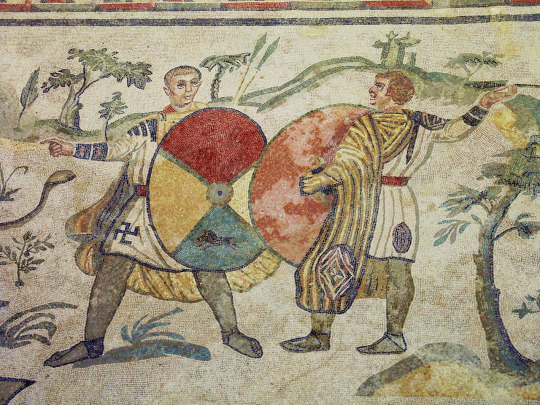
All over Europe thorough the early Middle Ages, the clothes were very similar in their basic shape and construction as in Rome and Greece. In Central and Northern Europe though people would wear pants under shorter tunics. There were exceptions to the everyone wearing a tunic trend. Celtic men wore braccae, which were pants, and short tunics and literally just shirts. Celts are the rare case, where I think we can say that men didn't wear dresses. Most other peoples in these colder areas wore at least knee-length tunics. Shorter tunics and trousers were worn again mostly by soldiers and slaves, so rarely any other woman than slave women. The trousers were though definitely trousers in Early Middle Ages. They were usually loose for easier construction and therefore not that similar to Roman leggings. However leggings style fitted pants were still used, especially by nobility. I'd say the loose trousers are a gray area. They wore both dresses and pants, but still definitely dresses. I'd say this style was very comparable to the 2000s miniskirts over jeans style. First one below is a reconstruction of Old Norse clothing by Danish history museum. The second is some celebrity from 2005. I see no difference.
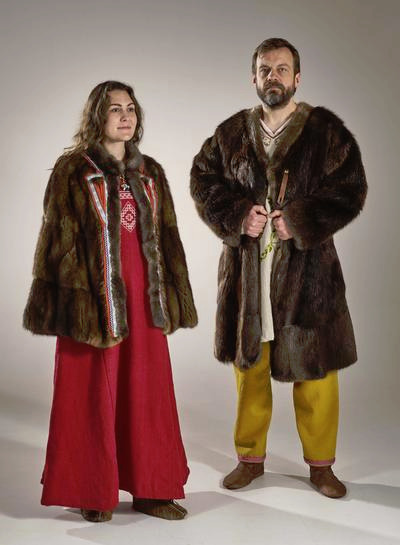

When we get to the high Middle Ages tunics are still used by both men and women, and still it's length is dependent on class and activity more than gender, but there's some new developments too. Pants and skirt combo is fully out and leggings' are back in in form of hose. Hose were not in fact pants and calling them leggings is also misleading. Really they are socks. Or at least that's how they started. As it has become a trend here they were used by everyone, not just men. During early Middle Ages they were worn often with the trousers, sometimes the trousers tucked inside them making them baggy. In high Middle Ages they became very long when used with shorter tunics, fully displacing the need for trousers. They would be tied to the waist to keep them up, as they were not knitted (knitting was being invented in Egypt around this time, and some knitting was introduced to Europe during middle Ages, but it really only took off much later during Renaissance Era) and therefore not stretchy. First picture is an example of that from 1440s. Another exciting development in the High Medieval era was bliaut in France and it's sphere of influence. Bliaut was an early attempt in Europe of a fitted dress. And again used by both men and women. The second illustration below from mid 12th century shows a noble man wearing a bliaut and nicely showing off his leg covered in fitted hose. Bliaut was usually likely fitted with lacing on the sides, but it wasn't tailored (tailoring wasn't really a thing just yet) and so created a wrinkled effect around the torso.
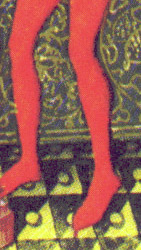

In the 14th century things really picked up in European fashion. European kingdoms finally started to become richer and the rich started to have some extra money to put into clothing, so new trends started to pop up rapidly. Tailoring became a thing and clothes could be now cut to be very fitted, which gave birth to fitted kirtle. At the same time having extra money meant being able to spend extra money on more fabric and to create very voluminous clothing, which gave birth to the houppelande.
Kirtle was once again worn by everyone. It wasn't an undergarment, for women that would be shift and men shirt and breeches, but it was an underlayer. It could be worn in public but often had at least another layer on top of it. The bodice part, including sleeves were very fitted with lacing or buttons (though there were over-layer kirtles that had different sleeves that changed with fashions and would be usually worn over a fitted kirtle). Men's kirtles were short, earlier in 14th century knee-length but towards the end of the century even shorter styles became fashionable in some areas. First picture below shows a man with knee-length kirtle from 1450s Italy.
Houppelande was also unisex. It was a loose full-length overgown with a lot of fabric that was gathered on the neckline and could be worn belted or unbelted. The sleeves were also wide and became increasingly wider (for men and women) later in the century and into the next century. Shorter gowns similar in style and construction to the houppelande were also fashionable for men. Both of these styles are seen in the second picture below from late 14th century.
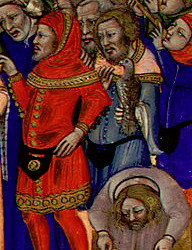

In the very end of 14th century, first signs of pantification of men can be seen. In France and it's sphere of influence the skirt part of the kirtle became so short it barely covered the breeches as seen below on these fashionable musicians from 1395-1400 France. Long houppelandes, length ranging from floor to calf, were still used by men though (the second picture, 1414 France), as were knee and thigh length gowns of similar loose style.

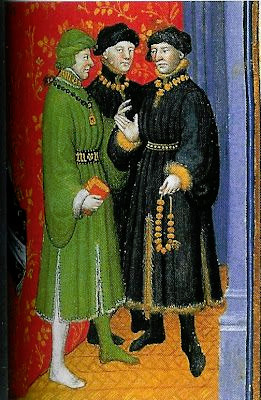
The hems continued to be short through the 15th century in France, but in other places like Italy and German sphere of influence, they were still fairly long, at least to mid thigh, through the first half of the century. In France at some point in late 13th century the very short under-kirtle started to be called doublet and they are just getting shorter in 1400s. The showing underwear problem was fixed by joined hose and the codpiece, signaling the entrance of The Sluttiest Era of men's fashion. Below is an example from 1450s Belgium of doublet and early codpiece in display. As you can see from the other figures, the overgowns of the previous century were also getting very, very short. In the next French example below from 1470s we can see the skirt shrink out of existence right before our eyes.
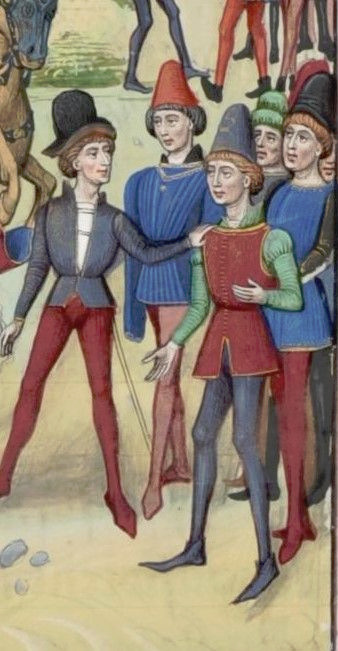

The very skimpy doublet and it's accompanying codpiece spread to the rest of the Europe in the second half of 15th century and it would only get sluttier from there. The Italians were just showing their full ass (example from 1490s). The dress was not gone yet though. The doublet and codpiece continued to be fashionable, but the overdress got longer again in the French area too. For example in the second example there's Italian soldiers in a knee length dresses from 1513.
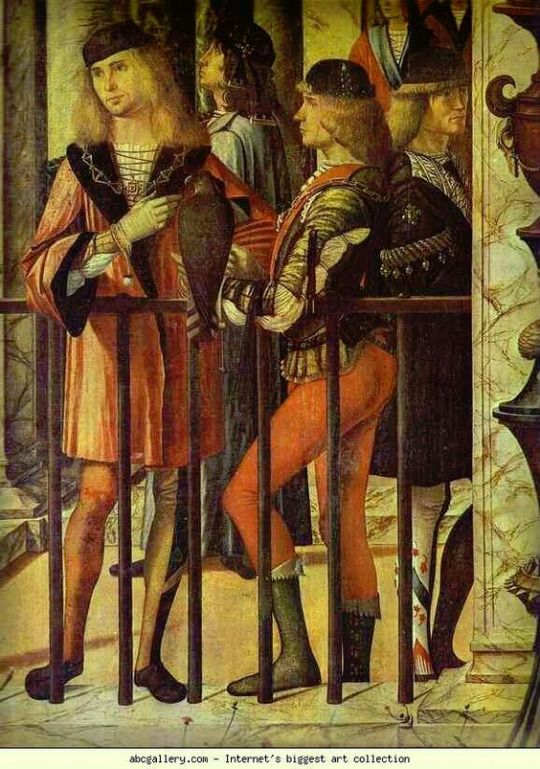
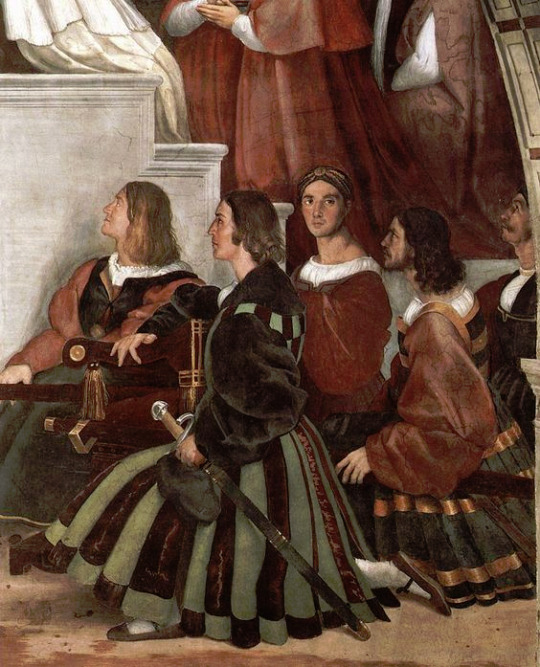
But we have to talk about the Germans. They went absolutely mad with the whole doublet and codpiece. Just look at this 1513 painting below (first one). But they did not only do it sluttier than everyone else, they also changed the course of men's fashion.
Let's take a detour talking about the Landsknecht, the mercenary pikeman army of the Holy Roman Empire. (I'm not that knowledgeable in war history so take my war history explanation with a grain of salt.) Pikemen had recently become a formidable counter-unit against cavalry, which earlier in the Medieval Era had been the most important units. Knights were the professional highly trained cavalry, which the whole feudal system leaned against. On the other hand land units were usually not made of professional soldiers. Landsknecht were formed in late 15th century as a professional army of pikemen. They were skilled and highly organized, and quickly became a decisive force in European wars. Their military significance gave them a lot of power in the Holy Roman Empire, some were even given knighthood, which previously wasn't possible for land units, and interestingly for us they were exempt from sumptuary laws. Sumptuary laws controlled who could wear what. As the bourgeois became richer in Europe in late Middle Ages and Renaissance Era, laws were enacted to limit certain fabrics, colors and styles from those outside nobility, to uphold the hierarchy between rich bourgeois and the nobles. The Landsknecht, who were well payed mercenaries (they would mutiny, if they didn't get payed enough), went immediately absolute mad with the power to bypass sumptuary laws. Crimes against fashion (affectionate) were committed. What do you do, when you have extra money and one of your privileges is to wear every color and fabric? You wear every color and fabric. At the same time. You wear them on top of each other and so they can be seen at the same time, you slash the outer layer. In the second image you can feast your eyes on the Landsknecht.


Just to give you a little more of that good stuff, here's a selection of some of my favorite Landsknecht illustrations. This is the peak male performance. Look at those codpieces. Look at those bare legs. The tiny shorts. And savor them.
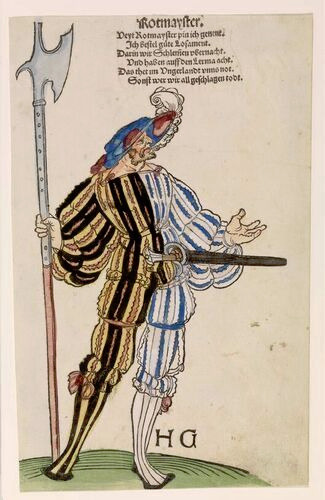
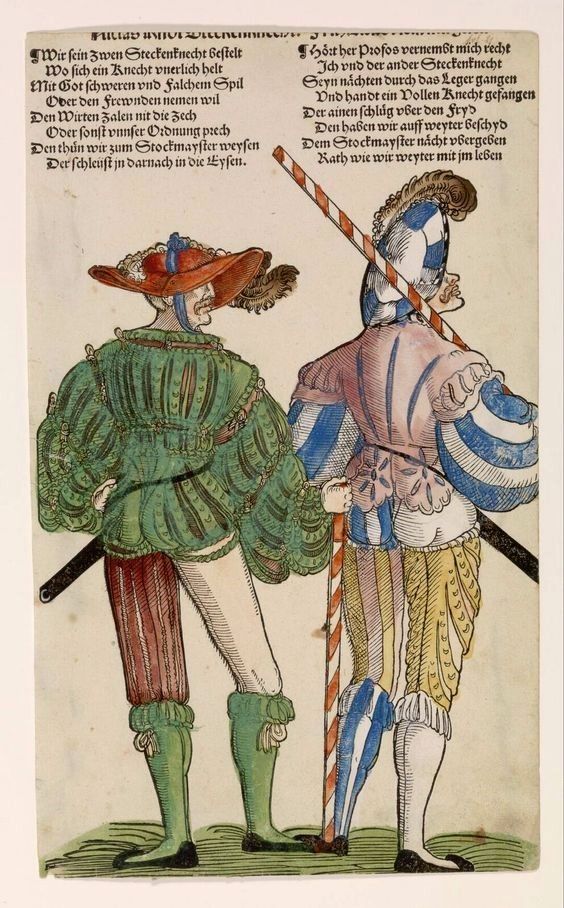
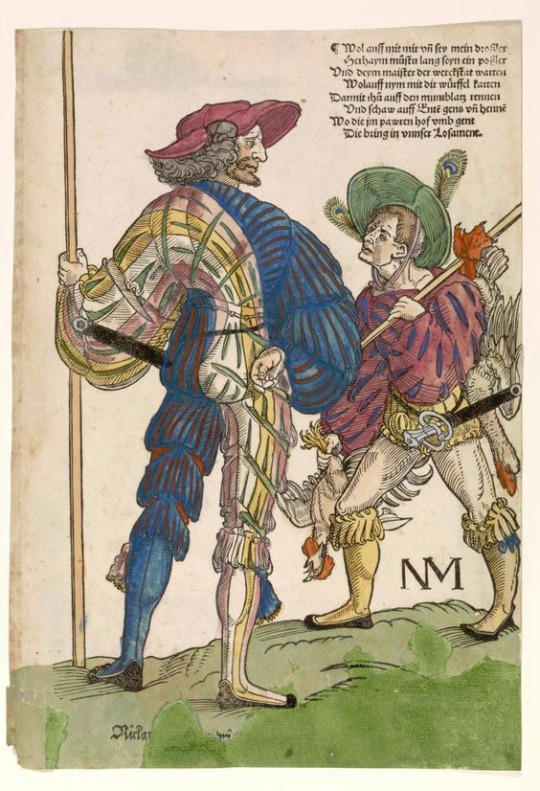
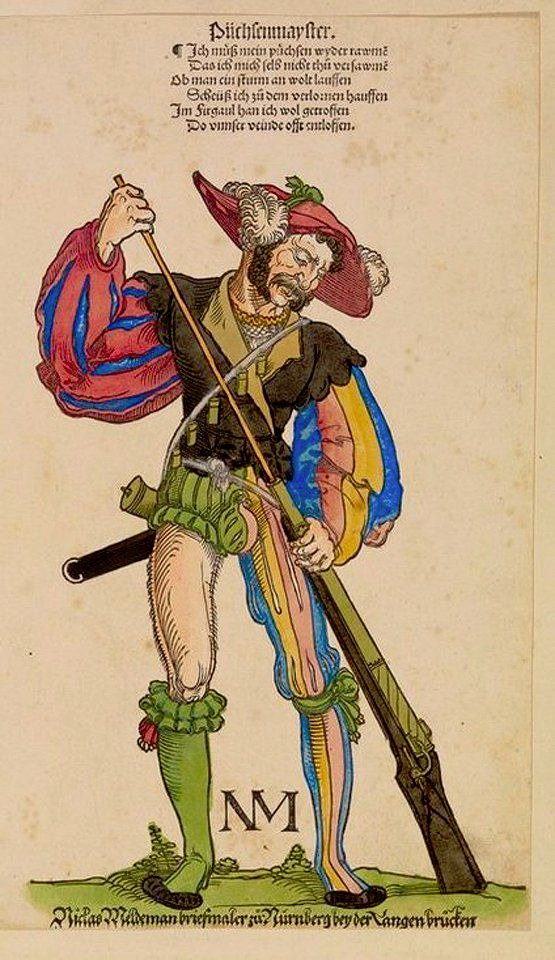
The Landsknecht were the hot shit. Their lavish and over the top influence quickly took over men's fashion in Germany in early 1500s. Slashing, the technique possibly started by them, but at least popularized by them, instantly spread all over Europe. That's how you get the typical Renaissance poof sleeves. They at first slashed the thighs of their hose, but it seems like to fit more of everything into their outfits, they started wearing the hose in two parts, upper hose and nether hose, which was a sort of return to the early Medieval trousers and knee-high hose style. The two part hose was adopted by the wider German men's fashion early in the century, but already in 1520s had spread to rest of Europe. It was first combined with the knee-length overdress that had made it's comeback in the turn of the century, like in this Italian painting from 1526 (first image). At this point knitting had become established and wide-spread craft in Europe and the stockings were born, replacing nether hose. They were basically nether hose, but from knitted fabric. The gown shortened again and turned into more of a jacket as the trunk hose became increasingly the centerpiece of the outfit, until in 1560s doublet - trunk hose combination emerged as the standard outerwear (as seen in the second example, 1569 Netherlands) putting the last nail on the coffin of the men's dress as well as the Sluttiest Era. The hose and doublet became profoundly un-slutty and un-horny, especially when the solemn Spanish influence spread all over with it's dark and muted colors.


Especially in Middle Ages, but thorough European history, trousers have been associated with soldiers. The largely accepted theory is that trousers were invented for horse riding, but in climates with cold winters, where short skirts are too cold, and long skirts are still a hazard when moving around, trousers (with or without a short skirt) are convenient for all kinds of other movement requiring activities like war. So by adopting hose as general men's clothing, men in 1500s associated masculinity with militarism. It was not a coincidence that the style came from Landsknecht. I may have been joking about them being "peak male performance", but really they were the new masculine ideals for the new age. At the time capitalism was taking form and European great powers had begun the process of violently conquering the world for money, so it's not surprising that the men, who fought for money and became rich and powerful doing so, were idealised.
Because of capitalism and increasingly centralized power, the feudal system was crumbling and with it the feudal social hierarchy. Capitalism shifted the wealth from land ownership (which feudal nobility was built upon) to capital and trade, deteriorating the hierarchy based on land. At the same time Reformation and centralized secular powers were weakening the power of the Church, wavering also the hierarchy justified by godly ordain. The ruling class was not about to give up their power, so a new social hierarchy needed to form. Through colonialism the concept of race was created and the new hierarchy was drawn from racial, gender and wealth lines. It was a long process, but it started in 1500s, and the increasing distinction between men's and women's fashions was part of drawing those lines. At the same time distinctions between white men and racialized men, as well as white women and racialized women were drawn. As in Europe up until this point, all over the world (with some exceptions) skirts were used by everyone. So when European men fully adopted the trousers, and trousers, as well as their association to military, were equated with masculinity, part of it was to emasculate racialized men, to draw distinctions.
Surprise, it was colonialism all along! Honestly if there's a societal or cultural change after Middle Ages, a good guess for the reason behind it is always colonialism. It won't be right every time, but quite a lot of times. Trousers as a concept is of course not related to colonialism, but the idea that trousers equal masculinity and especially the idea that skirts equal femininity are. So I guess decolonize masculinity by wearing skirts?
#this has been sitting in my drafts almost finished for like a year or something#historical fashion#fashion history#fashion#history#dress history#men's historical fashion#renaissance fashion#medieval fashion#western fashion#western fashion history#landsknecht
3K notes
·
View notes
Text

Tfw you thrift a killer sweater in the morning and wear it out for your evening plans. ⚔️🛡️🏰
#thrifting#thrifstorefinds#sweater#Plaid#medieval#Fashion#Ootd#Gay#Queer#nonbinary#moustache#Gay men#gay boys#Gay guys#Me#my face
133 notes
·
View notes
Text
Identifying J.C. Walker's Illustrations
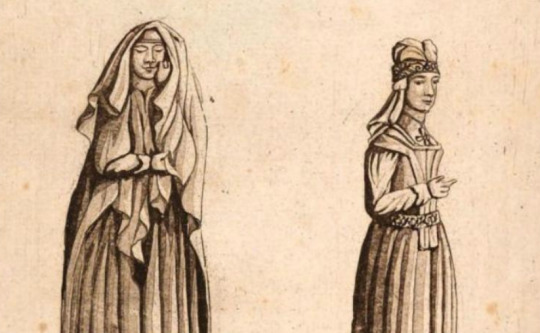
An Historical Essay on the Dress of the Ancient and Modern Irish by Joseph Cooper Walker published in 1788 was the first major work published on Irish dress history. Due to a combination of the limited information known at the time, and his erroneous assumption that Irish dress didn't change for the entirety of the Middle ages, Walker got a lot of things wrong, so his writing isn't cited much anymore. Some of his illustrations, however, are still used.
Because Walker lived before the invention of photography, he used drawings of historical Irish art created by colleagues and family to illustrate his book. I decided to track down the original works of art to see how Walker's drawings compared. I am resorting these into roughly chronological order, because Walker's lack of regard for chronology makes my head hurt.
The High Crosses, 9-10th centuries:
Ireland's high crosses have unfortunately lost a lot of their detail due to erosion, making these hard to identify. Sadly, the breeches with a fitted knee-band and the skirt gathered to a waistband look more Late Medieval or Early Modern than they do Early Medieval, so I don't think these are reliable depictions of the lost detail.
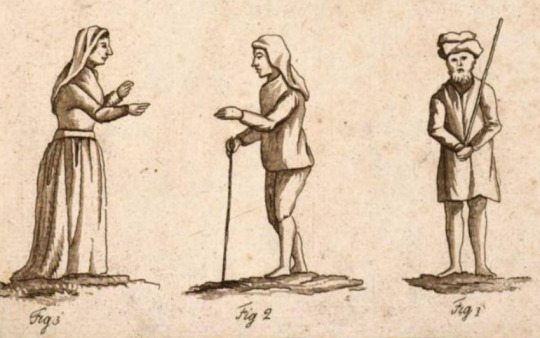
Plate 1: Figure 1 (right) is supposed to be from the Clonmacnoise Cross of Scripture. At a guess, it's based off the guard on the right arresting Jesus:
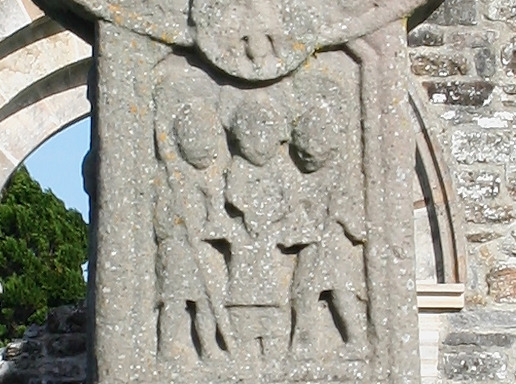
Figures 2 and 3 are based off a high cross fragment at Old Kilcullen, County Kildare. Unfortunately, I don't think the original carving survived. I initially blamed its loss on the United Irishmen, but this drawing from 1889 convinced me that acid rain was the real culprit.
Plate 5 Figure 1 is supposed to be a king from Muiredach's cross. The closest image I could find on the actual cross is Cain killing Able:

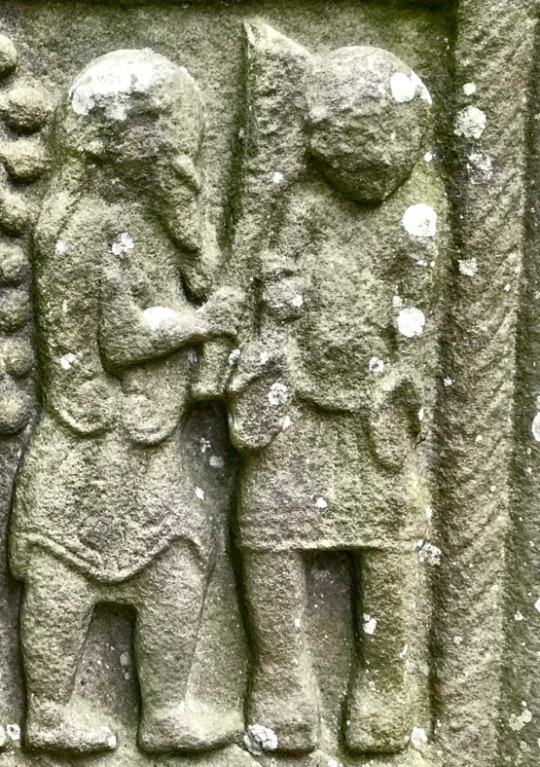
Ironically, Cain and Able have more embellishment on their clothes than the "king" based off of them.
12th century:
Plate 1 Figure 5 is from the capital of an arch at St. Saviour's Priory in Glendalough, County Wicklow. The drawing gives the impression that the sides of the head were shaved and the hair was deliberately curled at the end. In the actual carving, the hair is slicked back at the sides and interlaced with adjacent design elements. These are stylistic elements of Irish Romanesque art and not intended to be a realistic depiction of an Irish hairstyle.
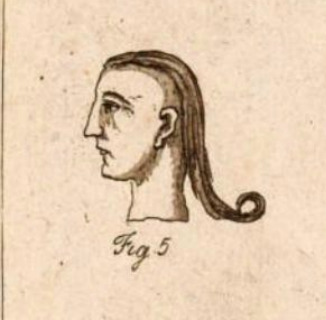

13th century:
Plate 4 is the late 13th century effigy of Felim O'Connor, Dominican Priory of St. Mary, Roscommon with a frontal of gallowglasses added in the 15th c.

This drawing is pretty accurate, although the gallowglasses are lacking some details like their quilted cloth gambesons.

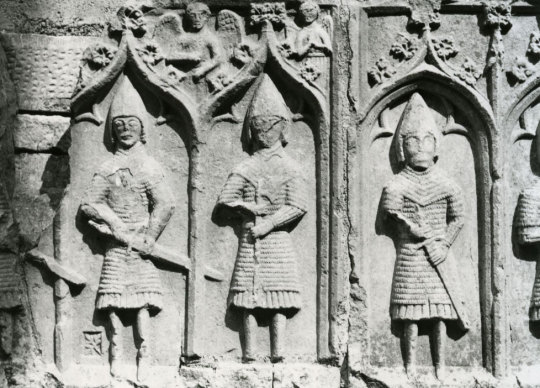
photos by Edwin Rae
I cannot find a good photo of Felim O'Connor's effigy, but Conor O'Brien's contemporary effigy at Corcomroe Abbey, County Clare wears the same style of clothing.
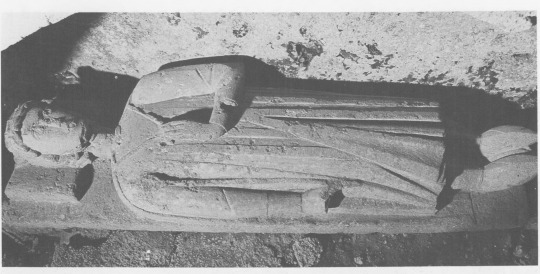
13-14th century?
Plate 6 is based on a sculpture from Athassel Priory in County Tipperary. I can't find a solid date for this one. Athassel Priory was built c1200 and then burnt and rebuilt twice before it was dissolved in 1541. The clothing style of the carving makes me think it's from the earlier part of this time frame.
The biggest thing the drawing gets wrong is the gender. This is a man, not a woman. The "necklace pendent" on his chest might have actually been a brooch holding his cloak, but the sculpture is now too damaged to tell. The drape of fabric at his side, which Walker calls a train, is actually the edge of his cloak. The drawing also leaves out the way his become more fitted below the elbow.
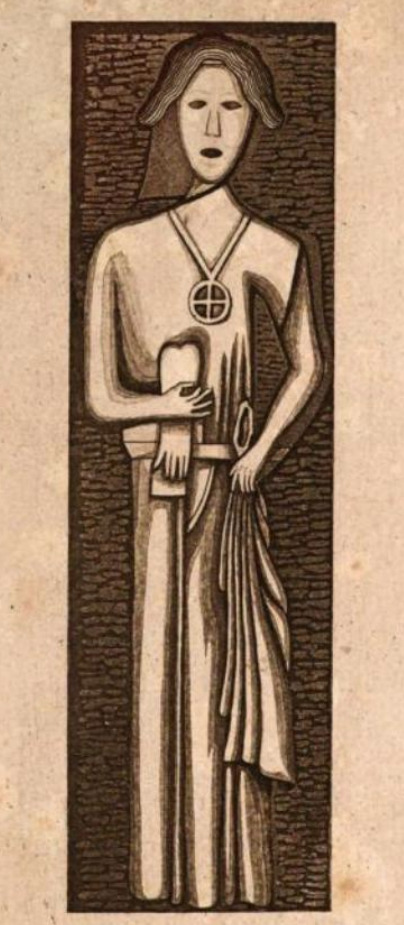

15th century:
Plate 3 Figures 1-3 are based off a painting at Knockmoy Abbey.

I'm pretty sure those are houppelandes on the left and center figures. This continental fashion influence shows up elsewhere in 15th c. Ireland (Dunlevy 1989). The drawing omits the massive houppelande sleeves and shortens their hems.

The painting is now badly weather and difficult to see. This is a more accurate drawing published in 1904. Recent photograph here
Plate 5 figure 2 and plate 1 figure 6 come from a 15th c. grave at the Dominican Friary, in Strade, County Mayo.
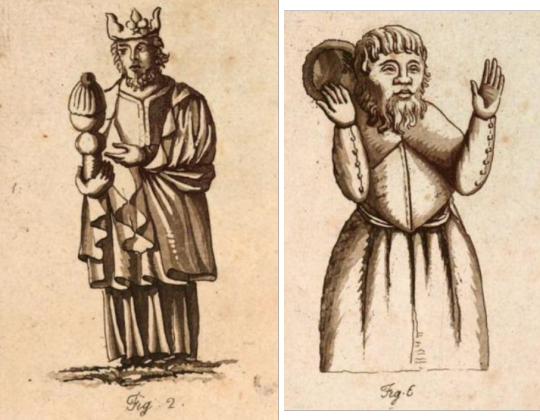
Figure 2 is a decent representation, although it adds a center front slit to the leine which I don't think is actually there. Figure 6 gets the silhouette of the cotehardie a bit wrong and omits the hanging belt accessories, but its greatest crime is that it makes the top of the hood look like a separate object. Walker actually misidenifies it as a Scotch bonnet.
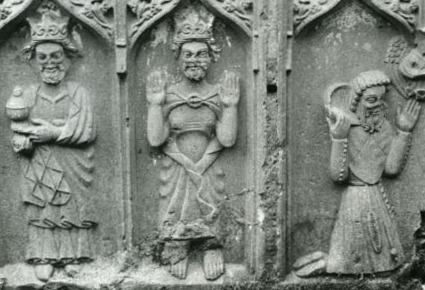
photo again by Edwin Rae
Plate 7 is Anne Plunket's effigy at St. Mary's Church, Howth, County Dublin. This drawing is decent, though the sleeves are a bit too slim. The cross necklace and belt decorations are no longer visible on the effigy.
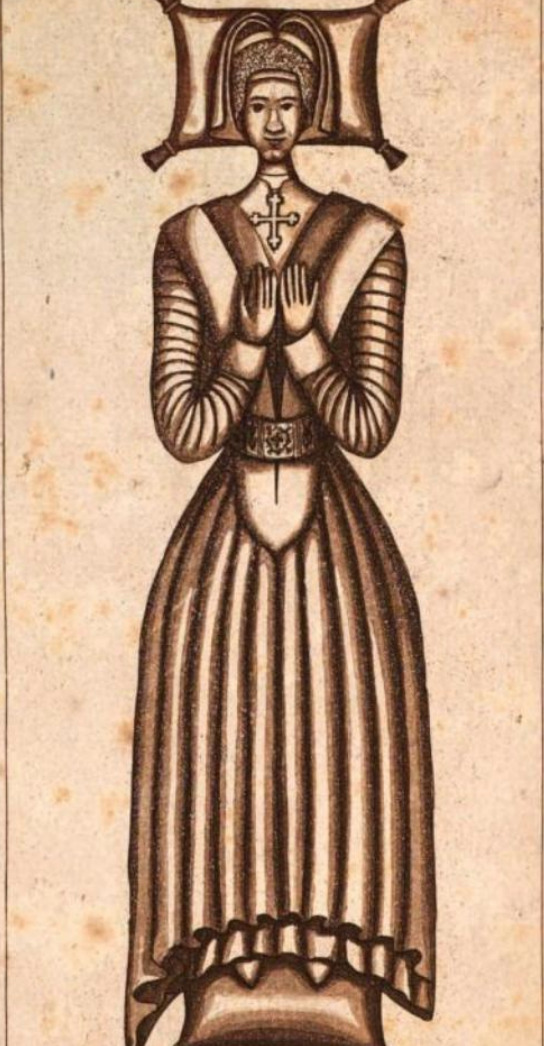
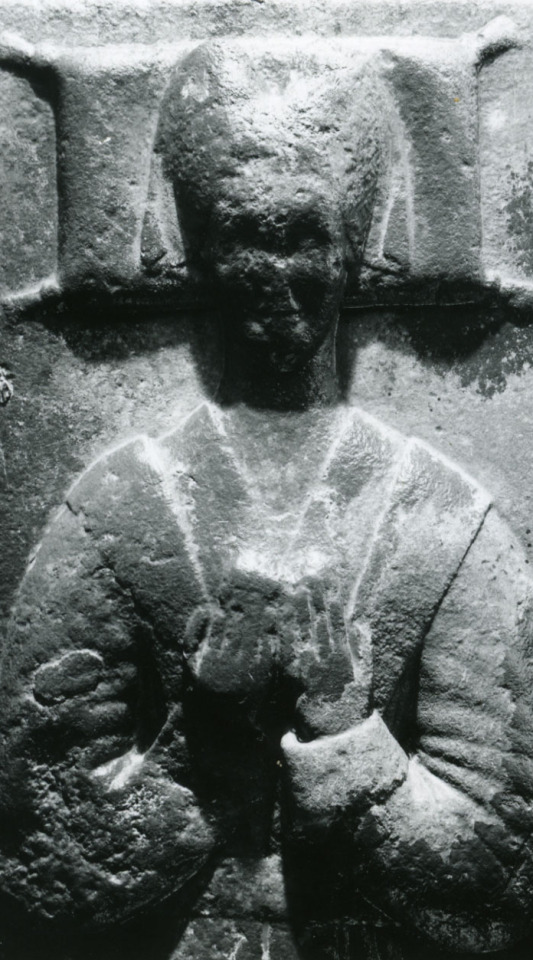
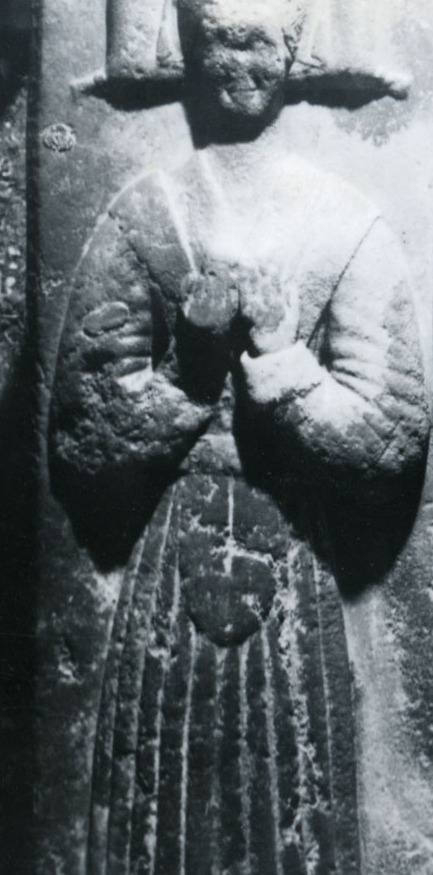
photos by MVP Edwin Rae
Plate 8 figures 1 and 2 are both based on a late 15th c. tomb at the New Abbey in Kilcullen, County Kildare. Figure 1 is based off a carving which is probably depicting St. Brigid, which makes her headwear the wimple of an abbess, not a laywoman's kerchief Walker. The drawing, however, omits her telltale crozier. The drawing makes it look like she has cuffed sleeves, but that is actually just the folds of her brat draped over her arm. It also shows her as wearing 2 layers of skirts when she is actually wearing a single lower garment with a hem circumference so large that it puddles at her feet.
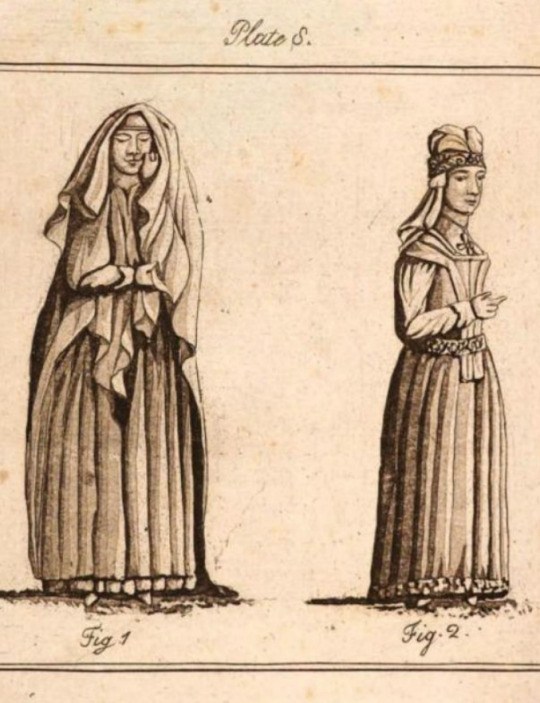

Figure 2 is based of Margaret Janico's effigy. The effigy is now too badly eroded to make out details, but it originally probably looked very similar to Margaret Janico's other effigy in St. Audoen's Church, Dublin. Unlike Anne Plunket's effigy above, the necklace and belt decorations are still faintly visible on the Dublin effigy. Figure 2 distorts the construction of the gown and headwear. This drawing makes the bodice of the gown look heavily stiffened or even boned like 17th c. stays. The houppelande on the effigy does not have stiffening in it.
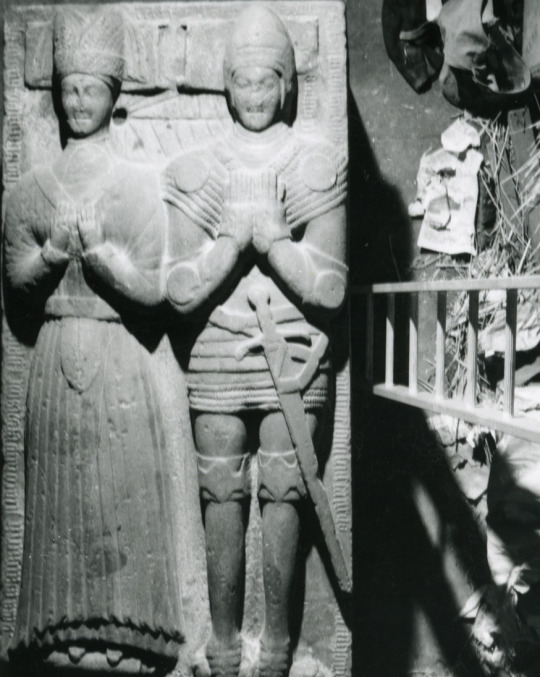
effigy of Margaret Janico and husband at St. Audoen's Church, Dublin (photos, once again, by my man Edwin)
The headpiece in the drawing looks like a linen kerchief wound up to form a turban with a decorated fillet tied over it. The headpiece on the effigy is probably actually a truncated hennin with a veil pinned to it like the one in this mid-15th c Burgundian painting by Petrus Christus.
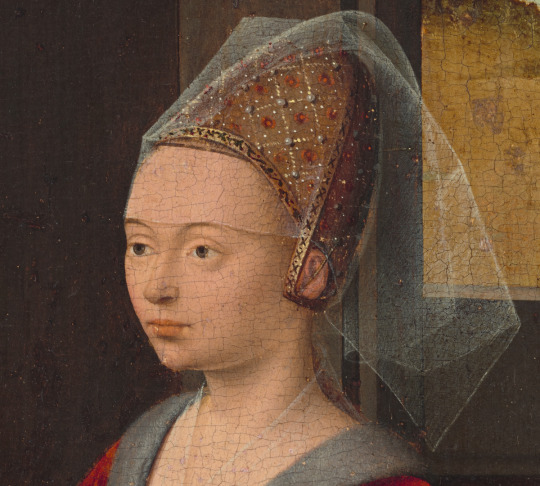
16th century:
Plate 9 is based on Katherine Molloy's early 16th c. effigy at Fertagh Church, in County Kilkenny. According to the artist's notes it was in "nearly perfect" condition at the time. I wish he had put more detail into the drawing.

(photo also by Edwin Rae)
17th century:
Plate 10 is based on The Taking of the Earl of Ormond in anno 1600. Walker's artist clearly fabricated some detail here, falsely giving the impression that triús were ankle-length. We know from extant examples from Kilcommon, Dungiven, and Killery that triús actually extended past the ankle, covering part of the wearer's foot (Dunlevy 1989, Henshall et al 1961).
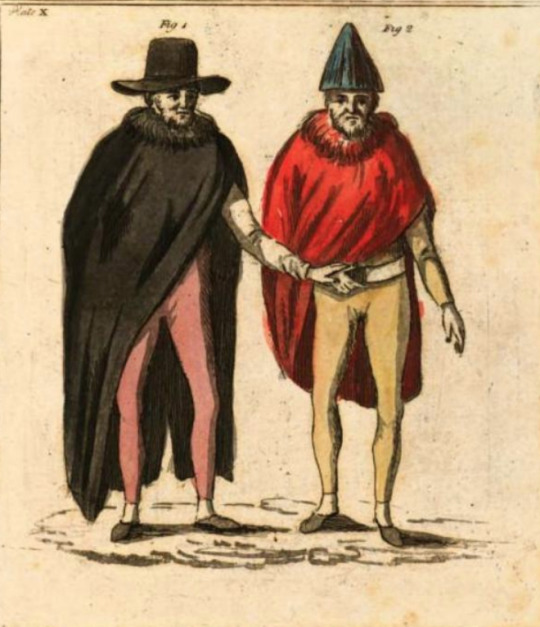

Plate 11 was taken from the tomb of Sir Gerald Aylmer (died 1634) and Juliana Nugent. Sadly, it appears to have been destroyed in the early 19th c, so I have no further pictures of it. The clothing looks to me like typical 1630s English fashion with loose gowns over doublets, falling bands, and linen cuffs.
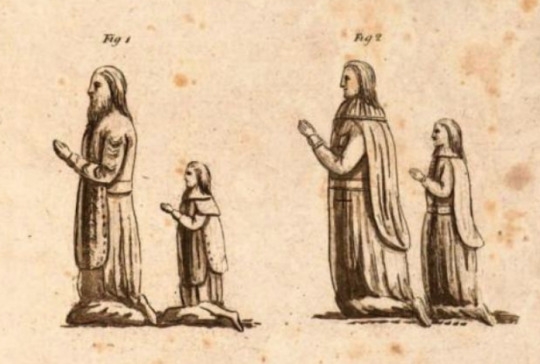
? Century
Plate 1 figure 4 is apparently from Old Kilcullen, County Kildare. I am not sure what this is based on. I haven't seen any Santa hats at Old Kilcullen. Or anywhere else in Medieval Ireland.
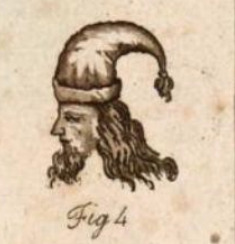
Bibliography:
Dunlevy, Mairead (1989). Dress in Ireland. B. T. Batsford LTD, London.
Henshall, Audrey, Seaby, Wilfred A., Lucas, A. T., Smith, A. G., and Connor, A. (1961). The Dungiven Costume. Ulster Journal of Archaeology, 24/25, 119-142. https://www.jstor.org/stable/20627382
Edwin Rae's invaluable collection of photographs of Late Medieval Irish art accessed via TARA.
#15th century#irish dress#dress history#irish history#art#early medieval#16th century#historical women's fashion#historical men's fashion#historical fashion#hiberno norman#gaelic ireland#headwear
11 notes
·
View notes
Text







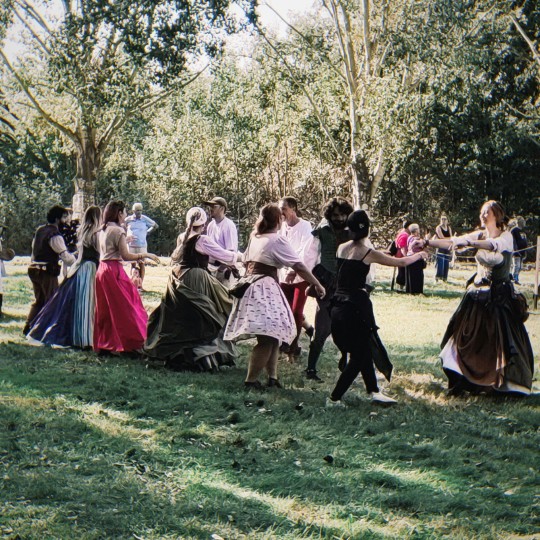
fiera medievale a trezzano che fai dici di no
#IT WAS!!! SO MUCH FUN!!!!!!!! they had IL PALIO!!! and DANCES!!!!! and True Men Sports!!!!!!!!!! (sword fight)#italian tag#italian post#i think everyone needs to see this let's go w the tag#medieval#medieval fashion#medieval fair#sword fight
11 notes
·
View notes
Text
I just realized what weenies cishet men are to claim women wearing makeup is “false advertisement” when their ancestors literally simped for women who wore corsets and balls gowns to alter their entire bodily shape, and never once complained like this.
13 notes
·
View notes
Text
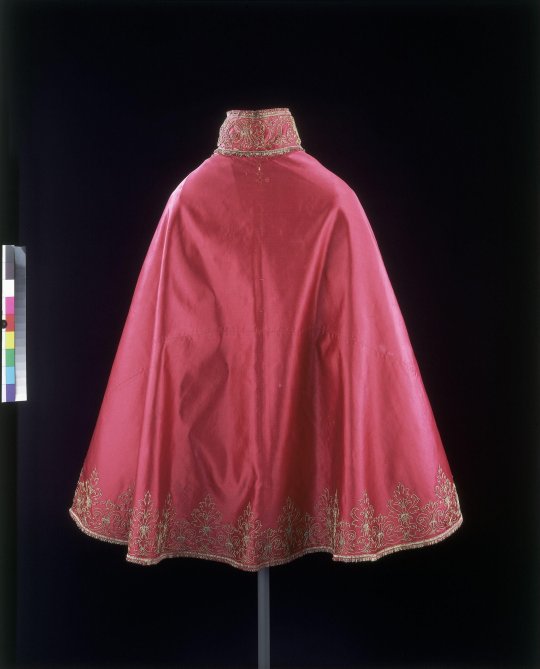
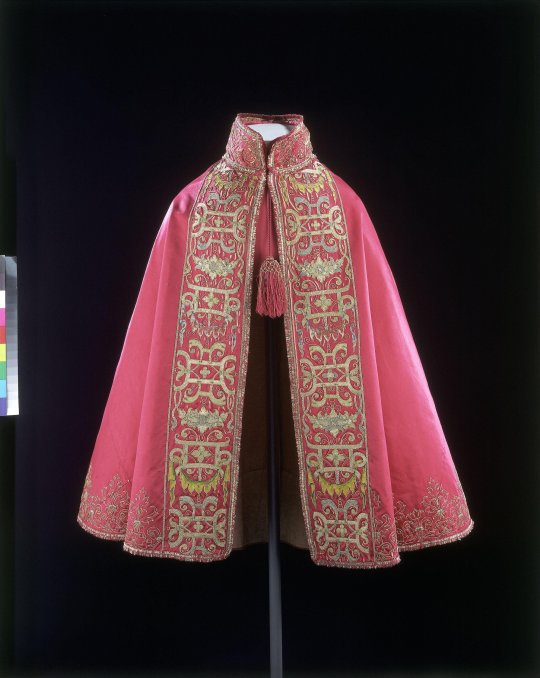

Man's crimson satin cloak, French, 1580-1600, metal thread embroidery
#silk#linen#gold#satin#sewing#hand sewing#hand sewn#1500s#1600s#16th century#16th century fashion#17th century#17th century fashion#menswear#men's fashion#renaissance#medieval#french#france#metal work#metal embroidery#hand embroidery#embroidered#silk satin#royalcore#princecore#knightcore#medievalcore#renaissancecore
8 notes
·
View notes
Text
"Men Complaining About Women's Fashion For 8 Minutes (And 500 Years) Straight"
youtube
#*literally any time period*#you can read late medieval men complaining about hennins and long gowns and ancient roman men complain about women dressing to expensively#etc.etc.#the 18th century one is hilarious lol#karolina zebrowska#fashion history#sexism#Youtube
5 notes
·
View notes
Text

This is an outfit from when Filonyn was very young, but they do still have it. Since it was before they were living among humans, they didn’t have to wear a big hat with it.
#my art#oc tag#my ocs#monster of the week#motw#i have a lot of different period outfits for them bc they’re fun to draw#this one’s 9th century AD. they still have it though#filonyn’s closet contains some of the best preserved medieval clothes in the world#entirely because they never throw shit away and are obsessive about keeping all their clothes in good condition#they’ll occasionally break these historic garments out for the local renaissance faire#they have a booth there where they sell fabrics.#general audiences are no longer interested in old fashioned handmade textiles so they must sell at the renaissance faire#really they’d probably do numbers on any social media website but unfortunately?#their main social media presence is an account on a sewing forum that was popular in the 1990s but now has almost no users#they go on there and post extremely detailed explanations of nearly lost sewing and weaving techniques#which are only viewed by the 3 or 4 old ladies who still use the website#when i design these outfits i combine elements from both menswear and womenswear from the time period#a lot of them look very feminine by modern standards but that’s just bc men’s fashion used to be better than it is now#the miniskirt here is actually menswear inspired. no medieval woman would wear that#but men did!!!!#the bodice is based on a gown though#filonyn
6 notes
·
View notes
Text

0 notes
Text

#vikings#medieval#viking cups#Vintage#wolf#wolves#cups for men#beer cups#timeless fashion online#living my life to the fullest channel#silver cups#birthday gift for men
0 notes
Text
In the current epidemic of rich Western women who cannot “choose” to eat, we see the continuation of an older, poorer tradition of women’s relation to food. Modern Western female dieting descends from a long history. Women have always had to eat differently from men: less and worse. In Hellenistic Rome, reports classicist Sarah B. Pomeroy, boys were rationed sixteen measures of meal to twelve measures allotted to girls. In medieval France, according to historian John Boswell, women received two thirds of the grain allocated to men. Throughout history, when there is only so much to eat, women get little, or none: A common explanation among anthropologists for female infanticide is that food shortage provokes it. According to UN publications, where hunger goes, women meet it first: In Bangladesh and Botswana, female infants die more frequently than male, and girls are more often malnourished, because they are given smaller portions. In Turkey, India, Pakistan, North Africa, and the Middle East, men get the lion’s share of what food there is, regardless of women’s caloric needs. “It is not the caloric value of work which is represented in the patterns of food consumption” of men in relation to women in North Africa, “nor is it a question of physiological needs…. Rather these patterns tend to guarantee priority rights to the ‘important’ members of society, that is, adult men.” In Morocco, if women are guests, “they will swear they have eaten already” or that they are not hungry. “Small girls soon learn to offer their share to visitors, to refuse meat and deny hunger.” A North African woman described by anthropologist Vanessa Mahler assured her fellow diners that “she preferred bones to meat.” Men, however, Mahler reports, “are supposed to be exempt from facing scarcity which is shared out among women and children.”
“Third World countries provide examples of undernourished female and well-nourished male children, where what food there is goes to the boys of the family,” a UN report testifies. Two thirds of women in Asia, half of all women in Africa, and a sixth of Latin American women are anemic—through lack of food. Fifty percent more Nepali women than men go blind from lack of food. Cross-culturally, men receive hot meals, more protein, and the first helpings of a dish, while women eat the cooling leftovers, often having to use deceit and cunning to get enough to eat. “Moreover, what food they do receive is consistently less nutritious.”
This pattern is not restricted to the Third World: Most Western women alive today can recall versions of it at their mothers’ or grandmothers’ table: British miners’ wives eating the grease-soaked bread left over after their husbands had eaten the meat; Italian and Jewish wives taking the part of the bird no one else would want.
These patterns of behavior are standard in the affluent West today, perpetuated by the culture of female caloric self-deprivation. A generation ago, the justification for this traditional apportioning shifted: Women still went without, ate leftovers, hoarded food, used deceit to get it—but blamed themselves. Our mothers still exiled themselves from the family circle that was eating cake with silver cutlery off Wedgwood china, and we would come upon them in the kitchen, furtively devouring the remains. The traditional pattern was cloaked in modern shame, but otherwise changed little. Weight control became its rationale once natural inferiority went out of fashion.
— Naomi Wolf (1990) The Beauty Myth
#hunger#long post#naomi wolf#the beauty myth#radblr#radfem#radical feminism#radfem safe#radical feminist safe#!!!
741 notes
·
View notes
Note
Hello!! Your blog has been a delight to browse through. I have a question, it may seem obvious but I'm just making sure- with codpieces, did the "cods" actually go inside the little pouch, or did the codpieces sort of just go over where they were located and people's "cods" were tucked back somewhere else? I assume the former, but the construction of some of the ones I've seen in portraits (very upturned) looks like it'd be uncomfortable.
Semi-related question, I've got a couple of characters that, for one reason or another, wear codpieces without being in possession of a "cod". Would that influence how it would lay on the body in any way? Would it be wildly inaccurate to suggest theirs were stuffed with cotton or something?
Again, your blog is very cool and I appreciate finding another historical clothing enjoyer :]
Thank you! :) It makes me happy to hear you've enjoyed this blog!
I'm not sure if you've already seen my post about the construction of the joined hose in which I also touch on the origins of the codpiece. Shortly the early cod pieces in late 15th century were invented to cover the genital area comfortably, when the hose were relatively stiff and very skintight.
Looking at the early codpieces, which were basically just a small piece of fabric tied on on the crotch it does make a lot of sense, clearly the it held the genitals inside it. Like in this 1470s painting.
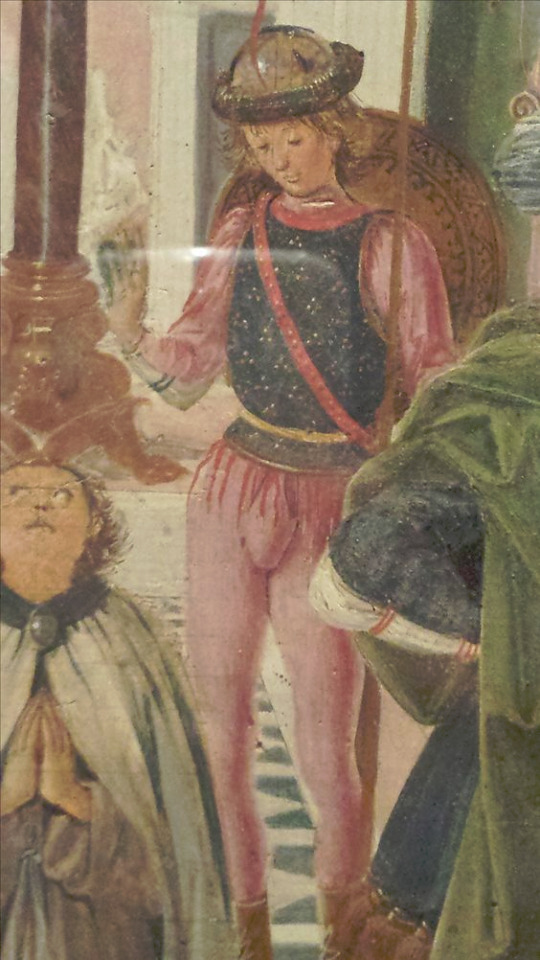
The men's fashion where they didn't wear hems and only very tight hose was mainly used by young fashionable men, who were not nobles, so soldiers, musicians, Venetian gondoliers etc. At the time valuables were generally tied to the belt in pouches, and especially when it comes to soldiers, who would also have knives and swords hanging on their hips, not having a protective layer of a skirt left their genitals quite vulnerable to hanging objects. Which is probably why they started padding their codpieces. The codpiece started to be made from two pieces of fabric making it more shapely and less flat, but it wasn't yet very extreme. There is padding but it's still easy to see how it would hold the genitals.
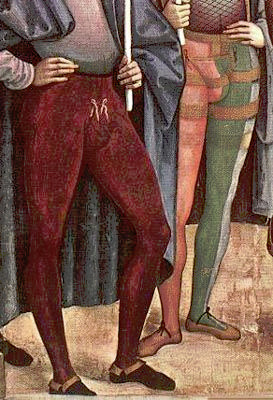
In 16th century it very quickly though turned very extreme. It became huge, what the French called appropriately a baguette. It was heavily padded, even boned to keep the shape.
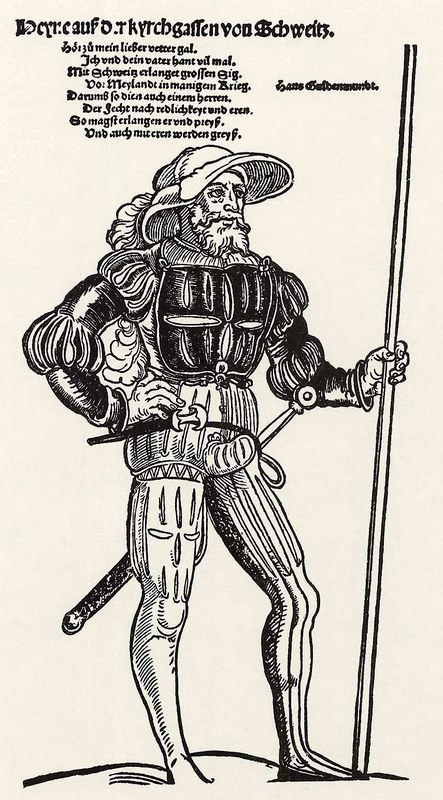
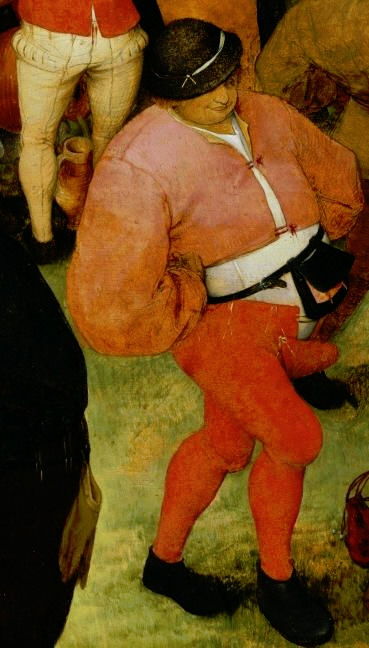
There's not much if any codpieces left from the time, so it's hard to say how they were specifically constructed. To me it seems quite probable, that they were still functionally the same as the earlier codpieces with a little pouch for the genitals and the rest being padding. There's a pretty interesting theory though about these extreme codpieces. At the time there was a big syphilis epidemic in Europe and they put all kinds of herbs and remedies on the genitals and wrapped the penis in bandages with the remedies. So the theory suggests that these baguettes may have been developed to hold and protect bandaged genitals, protect the fashion fabrics from the staining remedies and also obscure that someone had the very stigmatized infection by making a very padded penis a fashion. There's a really interesting paper about it, which also goes into detail about the codpiece.
So the genitals were held inside the codpiece one way or another. And to answer the other question, padding the codpieces was already standard practice so padding it a little bit more if one didn't have outward genitals like that is very believable to me. In fact, people would even hide some valuables inside their very large and padded codpieces. Even in the earliest codpieces made from flat fabric you could easily add a little extra stuffing to the under-breeches or the chemise tucked in to the hose. Though I'd doubt they'd use cotton as padding, since cotton wasn't readily available at the time in Europe. (It was all imported from Asia, since it didn't grow in Europe and Europeans didn't know how to weave cotton, so it was used on very specific purposes, like lining doublets.) More likely wool, linen or horsehair.
#cw: genitals mentioned#answers#historical fashion#dress history#fashion history#men's historical fashion#renaissance fashion#medieval fashion
90 notes
·
View notes
Text
Hogwarts Fashion During Hogwarts Legacy
A cheat-sheet for making your writing/art historically accurate, and some inspiration for your MC - women's addition.

Victorian fashion was complicated, both in terms of the construction and the rules that dictated when certain garments could be worn. Age played an important role in what a person was permitted to wear, so lets break it down that way:
Younger Students (Roughly years 1-4)
Generally speaking, girls dressed in similar styles to their mothers, but with altered hemline lengths. Up until roughly 13-14 years old (exact ages were decided by the girl's family) her hemline would fall around the knee. At 14 it would be lowered to the middle of the shins.
At this age girls would wear dresses, and so you could suggest that Hogwarts uniforms for girls at this age would not consist of the shirt and skirt combo that MC and various NPCs wear.
Most schools in the 1890s did not have set uniforms, but instead girls were expected to wear an apron to protect their clothes from ink and chalk dust.
At this age it was still considered socially acceptable for girls to wear their hair down, or in more simple hairstyles like braids. Popular hair accessories included ribbons and straw hats.
Time for some examples:

This is an example of a day dress (casual clothes) from 1893. Smocking (the embroidery technique used at the collar, waist and cuffs) was popular in young girls clothes.

Another example of children in day dress. The girl on the far left is probably about 13-14, the older girl on the right is closer to 15.
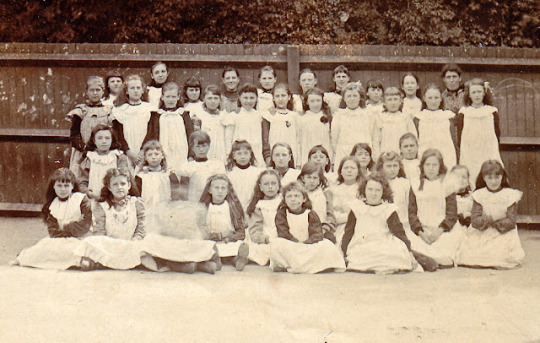
An example of the aprons worn by younger students.
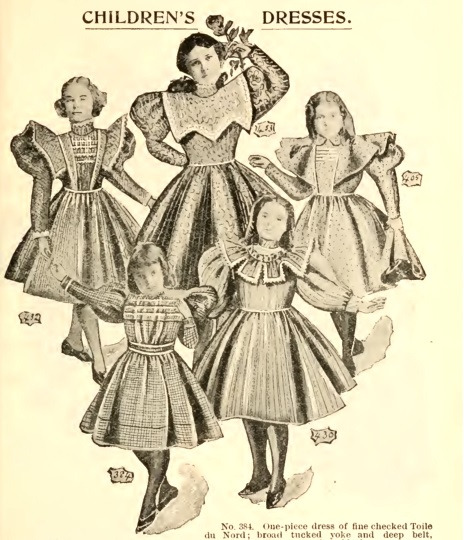
Details of the dresses worn underneath (technically from 1897 but the styles are fairly similar)
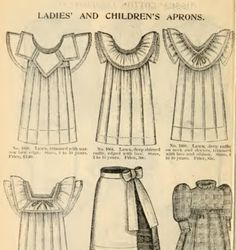
Details of the aprons worn
Older Students (Roughly years 5-7)
Around the time that the MC joins at Hogwarts, she would, depending on her personal preferences, have kept her skirt at her mid shin or dropped the hem to her ankles. Around the age of 17, girls would be expected to fully let down their hems to the floor, signifying their shift to adulthood.
At this point dresses would become less popular during the day, and were replaced by blouses (complete with very large sleeves) and a skirt. Men's tailoring and sports clothes shaped women's fashion at the time, and greatly influenced what girls wore at this age.
Girls would also typically stop wearing their hair down during the day, resorting to simple up-dos instead.
The time at which each girl made these changes depended on her and her family. While some girls had no choice but to listen to their parents, often they were able to bargain for an extra few months if they so wished.
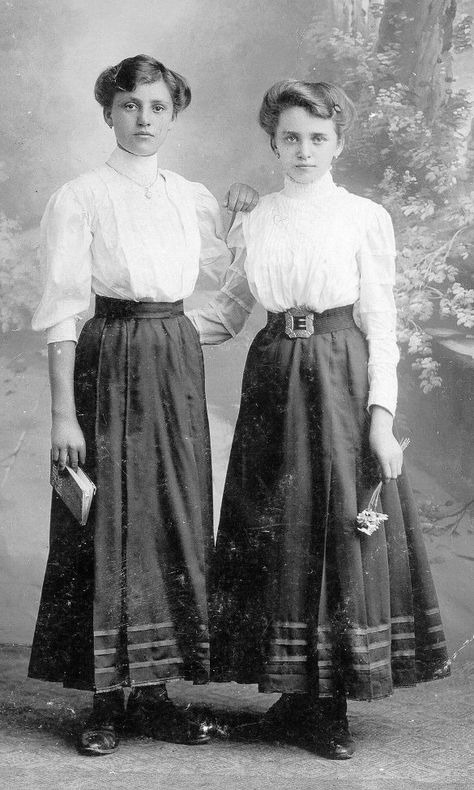
An example of two girls around the age of 15 in very typical day outfits.
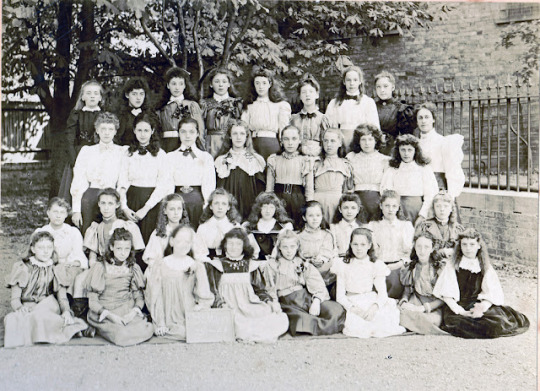
A selection of school girls - those sitting are no older than 14, those standing are no older than 16.
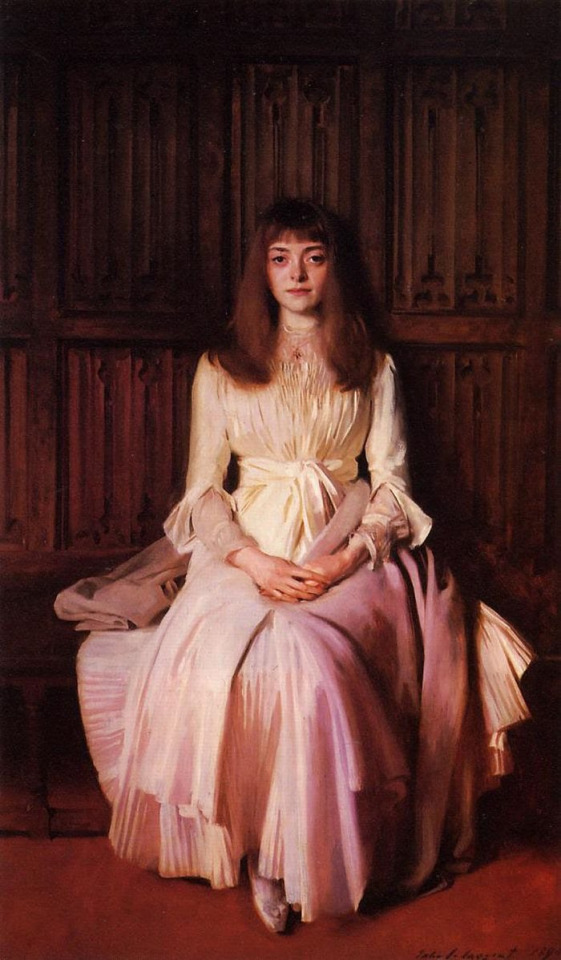

At the age of 15-16 girls would begin to attend more family functions and required new styles of clothes. These paintings show the same tea gown. These were made to be worn at home, never in public, when the family was hosted guests or a less formal dinner. They could be worn at all times of the day.
Day clothes for students who dressed as adults (17+):

A British Upper VI class (age 17-18) and some teachers in 1894. All girls now wear dresses with their hems on the ground, and hair tied up.
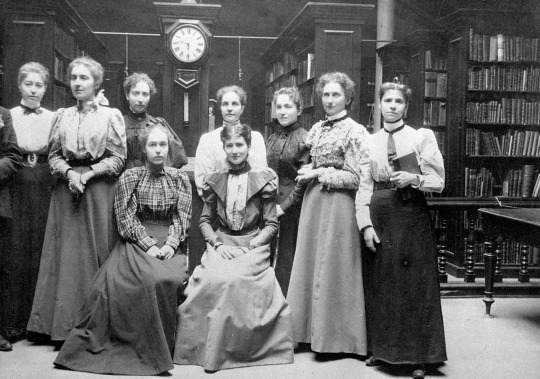
Middle class girls fashion in the 1890s
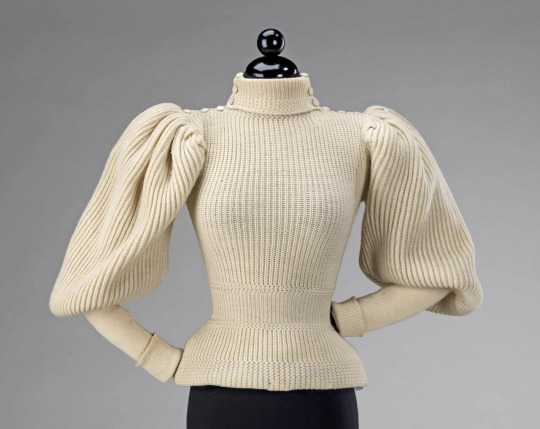
A Woman's sweater from 1895
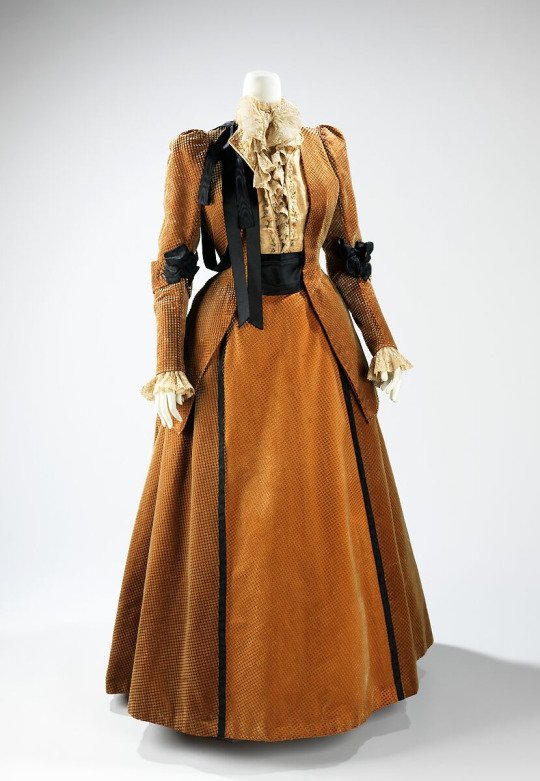
Walking outfit from 1894 - essentially a more substantial outfit for spending time outdoors.

A more expensive version of a day outfit.
Tea gowns:
Generally identified by their loose fit, high neckline, and a train that falls from the shoulders. Additionally they may also be made with a large coat over the top. The shape was inspired by medieval fashion and so they're a good source of inspiration for the wizarding world imo.

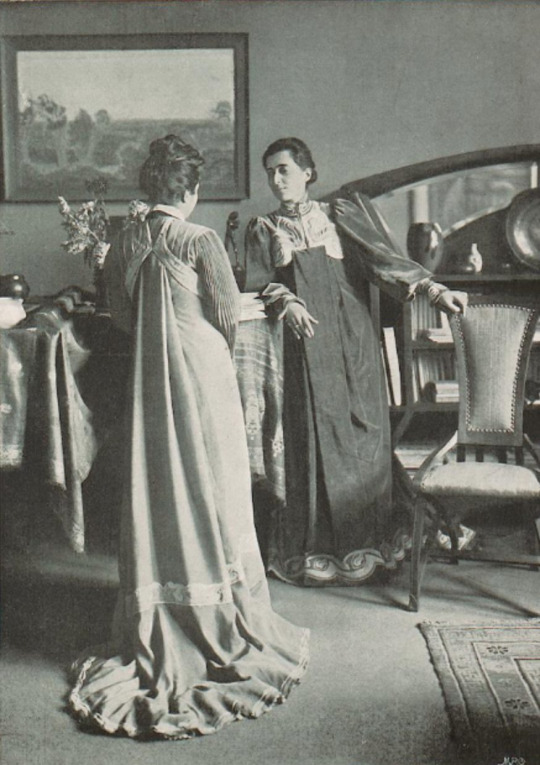


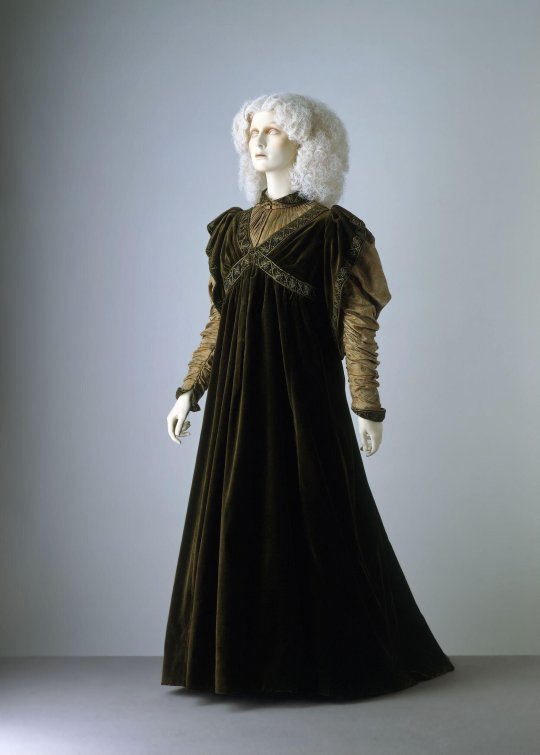
Evening gowns:
Worn for the most formal evening events, and generally expose more skin than day clothes. Staple accessories included fans, opera gloves, and (if you're that way inclined) tiaras were coming into popularity at this time.
Rule of thumb for all fashion at this time, the sleeves get largest in the middle of the decade, and shrink back down again towards the end.

1894

1893

1898

1893-1895

1894

1898
#Wow first post on this account is the nerdiest thing i could possibly pick#enjoy!#hogwarts legacy#harry potter hogwarts game#sebastian sallow#sebastian sallow x mc#sebastian sallow x you#sebastian sallow x reader#ominis gaunt#ominis gaunt x you#ominis gaunt x reader#garreth weasley#garreth weasley x mc#garreth weasley x reader#ominis gaunt x mc#hogwarts legacy art#hogwarts legacy mc#historical references#fashion references#1890s
2K notes
·
View notes
Text
The “natural” and “evolutionary” preference for hourglass shapes would be news to medieval male Europeans, who as we have seen were much more interested in pear shapes. How do we explain medieval men’s desire for pot bellies if men analyze women’s bodies for signs that they may be pregnant and eschew them if they are? And what about today’s high fashion models who are tall, have small to medium-sized breasts, and slim hips yet are considered the epitome of the ideal body? All these designations of attractiveness leave out most women, even if they turn to a surgical option.
Further, our society does not praise most of the other medieval beauty preferences. We may still regard blond hair as a beauty ideal, but we are fickle on much else. In the last fifty years, we have lauded tanned skin and fair complexions—note that Black and brown women’s skin tones don’t even enter into Western beauty standards. Eyebrows go from pencil thin to bushy. And we don’t share the medieval penchant for “high free” foreheads. If standards are based on evolutionary processes, why do our current preferences differ from older ones, and why have ours changed even during different decades?
There is no single and consistent beauty ideal that has existed over time, even within Europe. Beauty is a social construct and has different characteristics in different ages. Justifying social beauty norms through scientific means is as much a social construction as Matthew of Vendôme’s effort was, and we can pay them exactly as much heed. Maybe less, because at least Matthew was giving us some poetry to read as well.
Eleanor Janega, The Once and Future Sex. 2023.
456 notes
·
View notes
Text
Let Your Knights Weep
One of the big things I've had to train myself out of when writing medieval historical fiction?
The stiff upper lip.
This used to really bewilder my editor, who for some time attempted to nudge me away from having my grown men weep and wail and blubber, but for me it's an essential part of the setting. Whether in grief or fear, medieval people did not hold things back.
Here are some of my favourite quotes to explain.
First, a couple from two great 20th century medievalists:
CS Lewis in his Letters put it this way:
“By the way, don't 'weep inwardly' and get a sore throat. If you must weep, weep: a good honest howl! I suspect we - and especially, my sex - don't cry enough now-a-days. Aeneas and Hector and Beowulf, Roland and Lancelot blubbered like schoolgirls, so why shouldn't we?”
Dorothy Sayers, in her fabulous Introduction to her translation of THE SONG OF ROLAND, speaking of Charlemagne discovering Roland's body on the battlefield:
Here too, I think we must not reckon it weakness in him that he is overcome by grief for Roland’s death, that he faints upon the body and has to be raised up by the barons and supported by them while he utters his lament. There are fashions in sensibility as in everything else. The idea that a strong man should react to great personal and national calamities by a slight compression of the lips and by silently throwing his cigarette into the fireplace is of very recent origin. By the standards of feudal epic, Charlemagne’s behaviour is perfectly correct. Fainting, weeping, and lamenting is what the situation calls for. The assembled knights and barons all decorously follow his example. They punctuate his lament with appropriate responses:
By hundred thousand the French for sorrow sigh;
There’s none of them but utters grievous cries.
At the end of the next laisse:
He tears his beard that is so white of hue,
Tears from his head his white hair by the roots;
And of the French an hundred thousand swoon.
We may take this response as being ritual and poetic; grief, like everything else in the Epic, is displayed on the heroic scale. Though men of the eleventh century did, in fact, display their emotions much more openly than we do, there is no reason to suppose that they made a practice of fainting away in chorus. But the gesture had their approval; that was how they liked to think of people behaving. In every age, art holds up to us the standard pattern of exemplary conduct, and real life does its best to conform. From Charlemagne’s weeping and fainting we can draw no conclusions about his character except that the poet has represented him as a perfect model of the “man of feeling” in the taste of the period.
OK, now let's dig into some quotes that I found just in Christopher Tyerman's Chronicles of the First Crusade and Joinville's Life of St Louis:
Truly you would have grieved and sobbed in pity when the Turks killed any of our men....
As for the knights, they stood about in a great state of gloom, wringing their hands because they were so frightened and miserable, not knowing what to do with themselves and their armour, and offering to sell their shields, valuable breastplates and helmets for threepence or fivepence or any price they could get....
When Guy, who was a very honourable knight, had heard these lies, he and all the others began to weep and to make loud lamentation....
They stayed in the houses cowering, some some for hunger and some for fear of the Turks....
Now at vigils, the time of trust in God’s compassion, many gave up hope and hurriedly lowered themselves with ropes from the wall-tops; and in the city soldiers, returning from the encounter, circulated widely a rumour that mass decapitation of the defenders was in store. To add weight to the terror, they too fled…
In the course of that day’s battle there had been many people, and of fine appearance too, who had come very shamefully flying over the little bridge you know of and had fled away so panic-stricken that all our attempts to make them stay with us had been in vain. I could tell you some of their names, but shall refrain from doing so, because they are now dead.
I could go on looking for quotes in all the other medieval literature I've read, but that would be beyond the scope of this Tumblr post.
In the meantime, this leads me to make some comments on how trauma was perceived.
In Jonathan Riley-Smith's The First Crusade and the Idea of Crusading, the author discusses the mental breakdowns suffered by the first crusaders during the second siege of Antioch, which caused many of them to flee at the moment of direst need:
In these stressful circumstances it is not surprising that the crusaders were often very frightened. At times, indeed, they seem to have been almost paralysed by a terror that they themselves could hardly comprehend. … When the crusade was bottled up in Antioch by Kerbogha's relief force it was gripped by such blind panic that there was the prospect of a mass break-out and on the night of 10 or 11 Juney 1098 Bohemond and Adhemar had the gates of the city closed. It is worth noting that many of those whom later chroniclers, writing after the events in comparative comfort in Europe, vilified for cowardice and desertion seem to have been treated more charitably by their fellow-crusaders, who must have understood what pressures they had been under.
--
In conclusion: the way we feel about things today in the English-speaking isn't necessarily the way people felt about things in the past (and this goes for other cultures, real or imagined, too). I'm continually catching myself writing people with stiff upper lips and emotional reservations, and having to remind myself that the culture was different back them. If a grown man wanted to weep, he could. That's a good thing.
(Oh, and my medieval historical fantasy? Check out the Watchers of Outremer series on Amazon or wherever books are sold!)
#history#writing#historical fiction#medieval history#medieval#middle ages#historical#masculinity#history of masculinity#toxic masculinity
807 notes
·
View notes
Text
okay! so. i’ve seen many people online say multiple times that the deleted scene of arthur giving merlin his mother’s sigil—
(you know, this one👇)

is essentially a medieval proposal, and that that’s probably the reason why the scene was cut. i’ve never really thought that much of it, but coming across the comment again earlier today, it made me wonder if it was actually historically accurate at all.
the short answer is no, but the long answer is a little bit more complex.
i spent about an hour or so combing through articles and other online resources, and couldn’t find a single source vouching for sigils/seals being used as a way to propose. i did, however, find these two pieces of information:
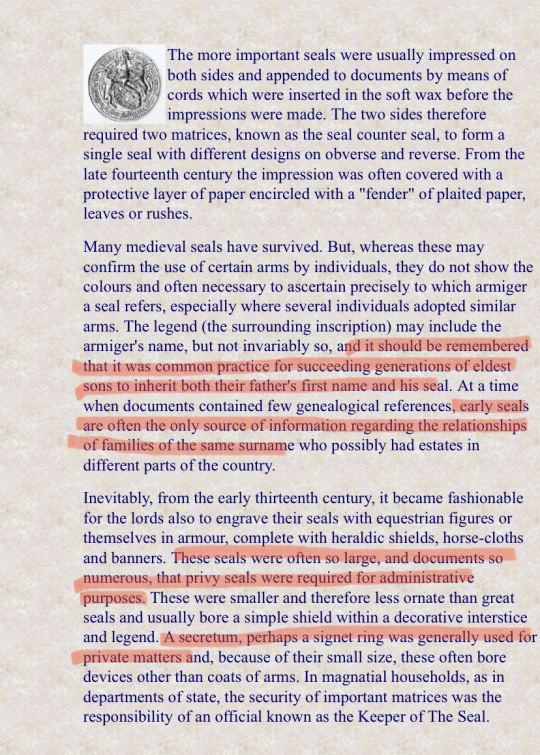

which make it clear that sigils/seals and signet rings reflect the same meaning and purpose, and that inheriting one signifies family ties and marks you above common men. signet rings were sometimes used as engagement rings (in fact, the ring arthur gives gwen in the series is a signet ring with his father’s sigil), but engagement rings were more commonly ornate gold bands set with precious stones like sapphires or rubies.
but! regardless of the fact that it isn’t technically a medieval way of proposing, i think you can still regard it as such, given the fact that it is essentially marking merlin as arthur’s family (his mother’s side no less!), and that arthur proposed to gwen in nearly the same fashion with the signet ring. i rest my case ✌️
#ivy.txt#merlin#bbc merlin#merthur#history tag#(i guess??)#tv shows will have you doing wild things first thing in the morning#edit: i’m absolutely by no means an expert on this btw so if anyone with more knowledge wants to add on/correct me feel more than free to!
1K notes
·
View notes